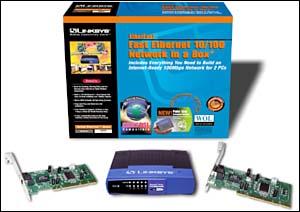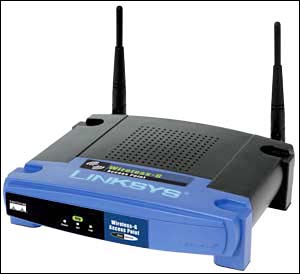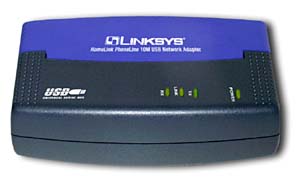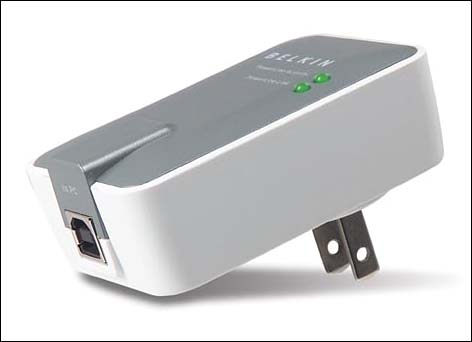Types of Network Connections
| Now that you know what to expect from your Media Center PC after your network is up and running, let's cover some basics. The first step in getting your PCs connected to each other is to set up your physical network. This means making physical data connections between the computers in your home. There is an ever-expanding list of network architectures to choose from, but the most popular options for home networking today include Ethernet, wireless, phone line, and power line. EthernetThe "old standby" in networking, Ethernet cables are one of the best supported and downright cheapest ways to get the job done. They can also provide much faster network speeds (typically 100Mbps) than the other options listed in this chapter, and they are easier to keep secure than the new-fangled and enormously popular wireless variety. Your Media Center PC comes with a network interface card (NIC) installed, so all you need to do is plug an Ethernet cable into it, then plug the other end into a device such as an Ethernet hub. Follow the same procedure for your other PCs, and you'll soon be in business.
If this is your first networking experience, you might consider buying a preconfigured Ethernet kit, such as the one pictured in Figure 22.1. Figure 22.1. This inexpensive kit from Linksys contains two NICs, cables, drivers, and a five-port hub. WirelessWireless networking is enjoying great popularity in the home market these days, primarily because of the absence of (you guessed it!) wires. Maybe your PCs are spread out around the house. Or maybe you have a mobile computer, such as a laptop or tablet PC, that you want to be able to use in different rooms as the mood strikes you. Maybe you just don't want to bother trying to conceal unsightly cables running from room to room. For any of these scenarios, a wireless network may be just the ticket. Balancing out the flexibility issue are the less-than - stellar speed and security issues. Achieving good signal strength from end to end of a home that is spread out, or that contains building materials that aren't conducive to wireless connections, can also be a challenge. Newer 802.11G equipment is now becoming widely available, and increasingly affordable. These products offer faster data transmissions than popular 802.11B networks, which reach speeds of only 11Mbps. The 802.11G systems support data transfers at 54Mbps (still only half of 100Mbps Ethernet). Whichever flavor of wireless you settle on, you'll need an "access point" device, which functions more or less like an Ethernet hub without wires, and a wireless network adapter for each PC on the network. For a typical example of a wireless access point, see Figure 22.2. Figure 22.2. The 802.11G equivalent of an Ethernet hub is a wireless access point, such as this WAP54G from Linksys. Phone LineA bit of a hybrid, the phone-line networking option offers simplicity, security, and affordability , though not particularly high performance. Instead of laying new network cables around your house, or relying on insecure airwaves to transmit data, you just tap into your existing telephone lines. The technology is called HPNA, after the Home Phoneline Networking Alliance which developed it. Speed for HPNA 2.0 adapters is limited to 10Mbps, which is comparable to 802.11B, the most pervasive form of "Wi-Fi," or wireless networking. All you need is an HPNA adapter (such as the one shown in Figure 22.3) for each PC. These are then connected to standard phone jacks . The result is instant network connectivity without laying new wires, and generally , there is no interference with normal voice use of your phone line. Figure 22.3. This HPNA 2.0 adapter connects to the PC via a USB cable.
Power LinePower-line computing works in a similar fashion to HPNA, except the network data is transmitted through your home's existing electrical wires instead of telephone lines. Typically, you plug the adapter into a standard 110-volt electrical outlet and attach a USB or Ethernet cable from the adapter to your PC. This has a slight edge over HPNA from a convenience standpoint, because most houses probably have fewer than 10 phone jacks, whereas they typically have dozens of electrical outlets. You don't need to give up a lot of speed, either, because power-line networks can operate at 14Mbps. Price can be a bit of a drawback. External USB adapters, such as the Belkin F5D4050 pictured in Figure 22.4, can retail for nearly $100, though street prices are typically much lower. Figure 22.4. Products such as Belkin's Powerline USB Adapter make network connections about as easy as they can get. |
EAN: 2147483647
Pages: 159
- Chapter III Two Models of Online Patronage: Why Do Consumers Shop on the Internet?
- Chapter IV How Consumers Think About Interactive Aspects of Web Advertising
- Chapter VII Objective and Perceived Complexity and Their Impacts on Internet Communication
- Chapter XIII Shopping Agent Web Sites: A Comparative Shopping Environment
- Chapter XVII Internet Markets and E-Loyalty



